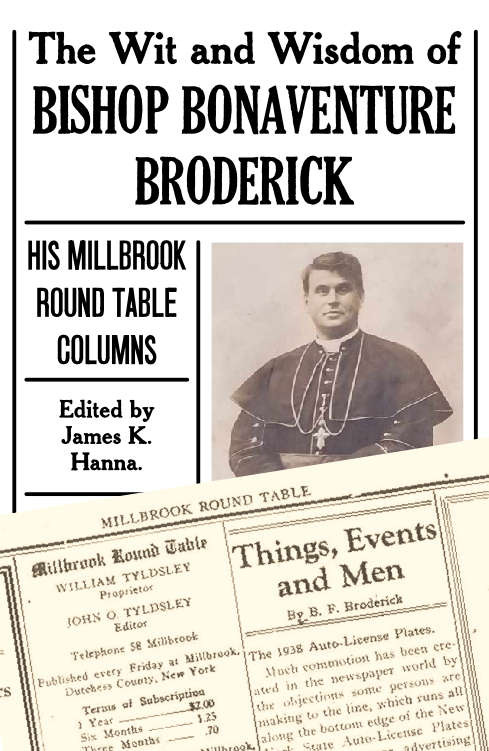
Baseball season is in full swing (see what I did there?) so today seems like a good day to share this piece from my recently published book The Wit & Wisdom of Bishop Bonaventure Broderick: His Millbrook Round Table Columns. Broderick’s weekly column was titled “Things, Events, and Men,” and the following was published June 16, 1939. Civil War hero Abner Doubleday (1819-1893) is often credited with developing the game in 1839, but the bishop has another idea garnered from his own youthful experience.
Who Invented Baseball?
Much controversy has been aroused throughout this country by the celebration of the Baseball Centennial, which was staged at Cooperstown, New York last Monday. One thing seems certain: the game of baseball was not played for the first time in that town or elsewhere on June 12, 1839.
Could baseball be so perfectly personified that it was able to speak it would probably answer the question “Who invented you?” by replying in the words of Topsy, “I s’pect I growed; don’t think nobody ever made me.”
The truth is that the game of baseball is evidently an evolution. As far back as 64 years ago I played it myself, and even then, it was yet and in it’s formative. The balls and bats used by schoolboys at that time were mostly homemade. The simplest form of playing with these was called “Knock up and Catch.”
Next came what was known as “One Old Cat.” Manifestly this was a corruption of the expression “One Hole Catch,” and was called this because only one base was used. This was not a stuffed bag of some sort, as is now used, but was marked by making a small hole in the ground by the placing on the selective spot a stone of considerable size, by a post or stake driven firmly into the earth, or by selecting to serve for the purpose a tree or some other naturally placed object that was nearby. As few as four people could play this form of the game. If six boys were available and willing to take part, another base was added, and the game then became “Two Old Cat.” It required a crowd of ten or a dozen before a third base could be added. The addition of this third base made the game “Baseball.” This was always played by sides. Two captains were first selected, and these immediately proceeded to “choose sides.” The right to make the first choice was determined by a maneuver with the bat. Holding this in a perpendicular position, one of the captains tossed it gently in that position to the other who stood a few feet away to catch it. This he always did with his right hand, which he wrapped tightly around it and such a shape as to cover as much as possible the length of the bat. The opposing captain placed his hand in a similar way above that of his opponent. Thus, alternately they wrapped their fingers hand over hand, around the back. When there no longer remained room for the entire hand to be clamped around the stick, the captain whose turn it was took the part of the bat which still projected between his thumb and forefinger and tried to swing it, thus held it around his head. If he succeeded in doing this his side won; if he dropped the bat in the attempt, the other captain was the winner.
If there were not enough men on the sides for the placing of a full set of outfielders, the game then was generally declared to be one of “Rounders.” This meant that to put a player “out” it was not necessary for one of the opposing players to hold the ball in his hand when he tagged him. In rounders a runner was declared “out” if he was struck by a ball thrown at him by an opponent.
“I’ve very much enjoyed reading Bonaventure’s wise and humorous thoughts, rendered with appealing brevity.” - Ron Hansen, novelist and author of Hotly in Pursuit of the Real



